Bosnia journal 2023, Part II: In
the city
I moved on to Sarajevo, where my feeling of alienation from "my old Bosnia"
dissipated. There was a ferment of activity there, many old friends, and some
new ones.
I walked around town, feeling at home—except that the main drag,
Maršal Tito Boulevard,
is more glitzy than ever. I remembered how battered that area was after the war,
and the excitement people felt when a couple of shops opened up, in 1998: a bakery, and a restaurant
that had salads. That was a big relief. But now this part of
Sarajevo is trying to perform like a world capital, dedicated to ostentatious
consumerism, leaving most of Sarajevo and Bosnia behind. On the side streets,
everything is more modest and genuine.
I had a visit with Nilo, a local journalist. We sat at the rooftop kafana above
the supermarket "Crvena Jabuka" (Red Apple); the weather was warm and sunny in
early November. One of the first things Nilo
said was
that this was "Dodik's store." He qualified that by saying Crvena Jabuka is
owned by a company from the Republika Srpska. So that could mean that Dodik has
a share in it. When shopping later in the grocery section, I saw that there were
sandwiches containing pork, a rarity in Sarajevo.
Talking about local politics: there's the phenomenon of the major parties—the
Bosniak nationalist SDA, the social democrats, and others—shedding members
periodically over the last 20 years. Each one of the defectors starts a new
party with approximately the same politics as the one they left. I asked Nilo
about the individuals who have been leaving the all-powerful Croat party, the
HDZ. He characterizes these people as "local sheriffs" who have power in places
like Livno, for example. There's a parallel with the mayor of Zenica who split
off from the Bosniak SDA party.
Now one of the bigger parties rising out of a defection from the SDA is that of
Dino Konaković,
leader of the NiP party (Narod
i Pravda—People
and Justice). Nilo
says that he is becoming more and more powerful, and that at some point his
party may not need to be in coalition with other parties in order to run the
government. I asked if Konaković
was popular and he said, "I don't know if he's popular, but he gets the votes."
Nilo
considers the NiP worse than the SDA. The SDA has by far been the leading
Bosniak party, ever since the war, but in recent years it has been slipping. Its
leader, Bakir Izetbegović, lost the race for the presidency two years ago, and
the NiP-led "Troika" coalition has edged out the SDA at the national level.
There is
always discussion of Dodik's standing threat to have the Republika Srpska secede
from Bosnia-Herzegovina. Everyone has their own opinion on whether this is a
possibility. Nilo asserted that there are no real
prospects that the RS could secede, and that Dodik knows this. No other country
would recognize the RS's independence, he says—although Dodik claims that 10
countries would recognize the RS right away. Presumably these would include
Russia and Hungary.
Nilo
also says that the economy of an independent RS would not be supportable, as a
significant amount of its funding comes from taxes collected at the state level.
Also, thousands of Serbs who live in the part of the RS near to Sarajevo work in
the city, one of the only places where there are jobs.
Thinking of Srebrenica, I commented to Nilo that it seemed to me that there's a
tacit operation, around Bosnia-Herzegovina, to kill the economy.
He
disagreed, pointing to successful local initiatives. He said that where there is
political support, development can happen. That is certainly not the case in
Srebrenica.
On the subject of foreign investment,
Nilo
pointed behind me to a building project I had not noticed, high up on Mt.
Trebević in RS territory. It is a massive, partially completed hotel or
apartment complex funded, he says, by "the Arabs." Arab companies and investors
are active in parts of Bosnia around Sarajevo.
I talked
with my friend Denis, a long-time activist, about local politics. He noted that
the Sarajevo Mayor
Karić, the
Bosniak member of the presidency, and some other top figures are all from the
social-democrat party, but that they are "not doing anything good for Sarajevo."
He says that
Karić is selling everything to the profiteers.
The city's budget had paid for restoration of the antique Bistrik train station
and turned it into a museum about Valter, the WWII hero. Then the city gave up
on that idea and sold the rights to the space to a Turkish company to make a
restaurant there. Karić has allowed the privatization of other prominent
attractions such as a viewpoint on a hill above the city as well. Denis's point
was that all these projects that are benefiting private businesses are being
financed by money from taxes in the city and the canton.
Denis corroborated Nilo's comment that the NiP, under Konaković, is "worse than
the SDA." He explained that their program is "more radical," for example, that
they are insisting that more Islam be taught in the public schools. "People can
go to the mosque for that," Denis commented.
I drove
with Miki up in the hills, passing by the restored Bistrik train station. We
were exploring, trying to find Kazani, but no passable roads led there. We gave
up and stopped at a kafana in Lukavica, which passes for the biggest nearby town
in the Republika Srpska.
Miki pointed across the street and told me that there used to be an RS army base
there—the one where Alija Izetbegović
had been held captive in May
1992 at the
beginning of the war. Now the area is covered with apartment houses, where
people have laundered their money. Miki said that people, including some
Bosniaks, are moving from the Federation to live in these homes, because the
rent is lower. It sounds like peaceful reintegration, to me. But the quality of
the work on these buildings, Miki says, is very poor.
There's no "there, there" in Lukavica. I've been there before. The town is quite
built up compared to 25 years ago, but there's nothing memorable, and every
block looks the same. A slight whiff of genocide. Everything is in Cyrillic,
including the graffiti.
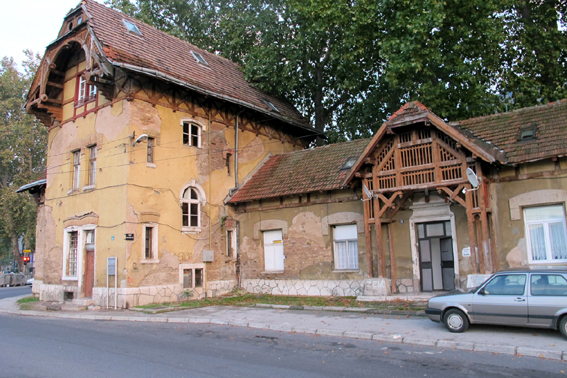
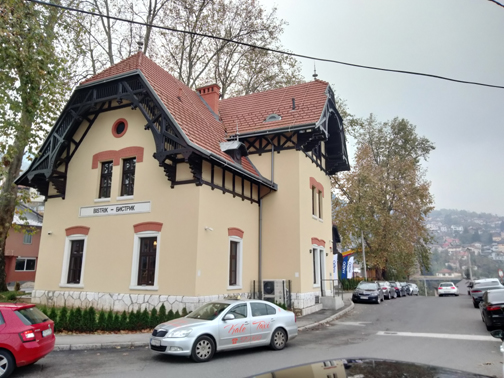
Bistrik train station, before and after restoration; now it's a Turkish-run
ice cream shop
Miki told me that some years ago, when his twins were 5 years old and in
kindergarten, another child asked them, "Are you Muslims?" They answered, "No,
we're twins." It sounds better in Bosnian:
Jeste li vi
Muslimani? Ne, mi smo blizanci.
Miki said they never talked in the family about who is a Muslim and so on. He
wondered how 5-year-olds are learning to think like this, and how they will be
when they are ten or twenty years old.
Looking for
Kazani
As
the weather started turning cool, one day I had some free time and decided to
try to find Kazani on my own. Kazani is a pit in the ground on the slopes of Mt.
Trebević,
high up on the south side of the city.
In Bosnia
and Herzegovina there are innumerable such pits formed by the uneven erosion of
karst formations. Dozens of such pits are notorious because of their use both in
the 1990s war and during World War II. In both wars soldiers killed their
captives and threw their bodies into the pits. You can learn more about that
history
here.
During the recent war, the most well-known instances of pits being filled with
massacre victims involved Serb extremists as executioners. However, in the case
of Kazani, there were fighters on the side of the Bosnian government, stationed
up on Trebević
near the front lines. This semi-autonomous militia was led by the gangster
Mušan
Caco
Topalović. During the war he was coming down into Sarajevo and grabbing people
who were not Bosniaks, and taking them up to Kazani, where he and his men killed
them.
Information about this episode came out into the open in the media, principally
in the magazine "BiH Dani," in late 1997 while I was living in Sarajevo. Caco
was notorious also for coming into the city and grabbing young men who were
partying in the clubs, and taking them up to the front lines to dig trenches.
Some of these
šminkers
(dandies)
were the sons of high officials.
For
this, Caco gained some popularity among the ordinary people who did not know
what else he was doing.
As the war dragged on into 1993, Caco's gang and other gangs were becoming more
of a law unto themselves in the city and on the front line. They operated
independently of the Bosnian army. In fact, some of these people, having been
criminals and living outside the law before the war, were among the first to
defend the city. But by 1993 they were controlling different zones of Sarajevo,
ignoring the local police and sometimes confronting them. Order was disappearing
in the city.
In the fall of 1993 the Sarajevo authorities decided to crack down on Caco's
group. Their first attempt was a spectacular failure; when police entered a
Sarajevo headquarters, Caco's men killed nine of them. One of those killed was
the son of the deputy minister of the Bosnian police. Not long after this
incident the police arrested Caco. Soon he was "shot while trying to escape."
Reporters still use this formulation today without apparent irony, but I doubt
anyone believes that's what happened.
Caco was buried in an out-of-the-way grave, but after the war, in late 1996, he
was reburied in Kovači
cemetery, the same honored location where Alija Izetbegović was later buried.
Thousands of people came out to attend his funeral—according
to one report, these were mainly other former members of the irregular military
groupings. One wonders whether they were aware that Caco had kidnapped and
killed dozens of Sarajevo citizens—mostly non-Bosniaks—and usurped their
apartments.
In the wake of the atrocities that Caco's men had committed, and the scandal of
his funeral, a dozen-odd men were tried and convicted of the crimes and
sentenced to minimal prison terms. Eventually the remains of 29 victims were
exhumed from Kazani pit and reburied. Others are still missing. After many years
of vacillation, the present mayor of Sarajevo, Benjamina Karić,
had a memorial plaque installed beside the pit. The words on the plaque are
themselves scandalous, because they
address the
killings without naming any names; no guilt or responsibility was noted—as if
what had happened was on the level of a car accident.
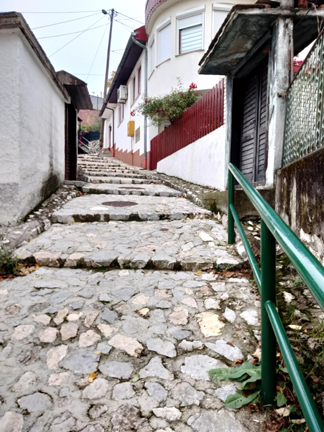
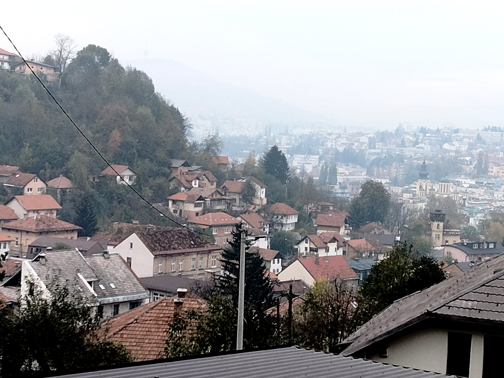
Part of the route up the hill toward Kazani, and the view looking back down to
Sarajevo
I walked up Bistrik Street, which leads from the old part of Sarajevo directly
up to the old railroad station that now stands as an ice cream shop with a view.
From there, above
Put Mladih
Muslimana
(Young Muslims Road, named after a WWII Islamist organization), the grade of the
road becomes closer to vertical than horizontal.
I continued up the steep hill to the last house. Behind it was a chicken coop,
and then the steep slopes of
Trebević.
There were no signs telling how to find the memorial monument. My cell phone's
GPS gave me a vague route to follow, so I improvised. I went up some unmarked
paths and ended up high up in the woods, on a cliff overlooking a steep
drop-off. This made me nervous about land mines, and I wasn't sure where the
boundary between the Federation and the Republika Srpska lay.
After a while I decided I wasn't going to get any closer to the monument that
way, and that I was probably going to get lost. So I headed back down. Then I
found one more path I hadn't tried. After about 10 minutes, much to my surprise,
I found the monument. It is a small one, a stone about a meter high and half as
wide, with about 15 names inscribed on it. They all look to be Serb names except
one. There were flowers were piled up around the stone. I later learned that
there had recently been a memorial observance there.
Behind the monument is the Kazani pit. Expecting to find a big ravine, I hadn't
understood this, but it really is just a narrow and deep pit. You can't see the
bottom. And it's only about 10 meters long. I imagined people being killed and
thrown in there, that mountain scenery being the last thing they saw. And I
imagined the people who came later, trying to find the remains of those who were
thrown into the pit. A gruesome job, to be sure.
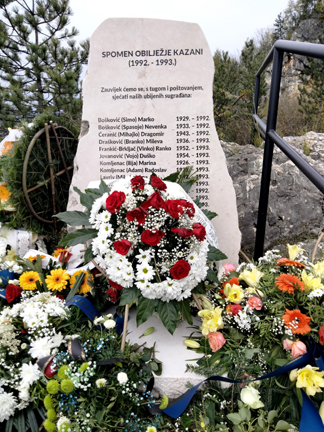
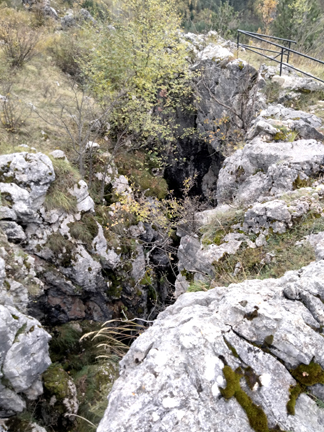
The controversial (content-free) monument to the victims at Kazani, and the
Kazani pit
Journal 1:
To Bosnia from Ukraine; Visiting
Srebrenica; Memorial Center
Journal 2: Sarajevo: Bistrik; Looking for Kazani
Journal 3: Gaza in Bosnia; Sevdalinka; Azra
Zornić
Journal 4: Krajina; more on Gaza;
Environmental activism